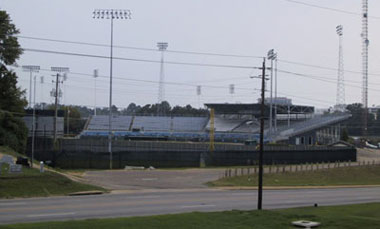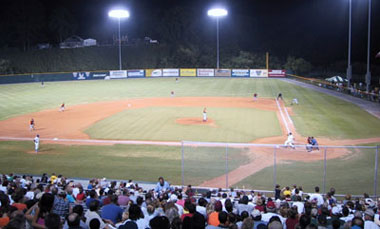
|
Montgomery's Paterson Field, built in 1949, has been home to the NCAA Division II Baseball Championship since 1985 and not much else. Now, in addition to the smattering of high school and small local college games that have been staged here, there is a new team in a new league that has brought the crowds back to an area abandoned by affiliated minor league baseball in 1980.
Riding the wave of increased popularity in minor league baseball of any level, the independent All-American Association opened play in June of 2001 with teams in six cities. With the city's population count reaching 200,000, Montgomery was a logical choice for a franchise, and the city heartily welcomed the return of organized baseball to Alabama's capital city for the first time since the AA Southern League Montgomery Rebels left town 20 years earlier. On the night of my attendance, a league record-breaking crowd of 8,102 overflowed Paterson Field's seating capacity of 7,000 on a humid Thursday evening, dubbed "Fan Appreciation Night," for the season finale of the inaugural season of the Montgomery Wings. The crowd was so large than when the gates opened an hour before the game was to begin, the line of fans clamoring to get in numbered in the hundreds, and it took 15 minutes for the initial pack to file through the turnstiles, with many more on their heels. With all the $8 box seats sold out, I settled for what the team had left, buying a $5 general admission ticket, and took my place in the back of the line. When taking in game at Paterson Field you will witness some things that you don't have in baseball anymore. For starters, the seating is mostly comprised of bleacher seats, but the majority of them are made of wood and come equipped with the seat backing that their metal counterparts usually lack. As the game wore on, I found out that bleachers made of wood, which were status quo fifty years ago, are far more comfortable than sitting on those made of metal. But the reason you don't find wooden bleachers today at the ballpark is because of the fire hazard that they pose. Among the notable fires to break out and destroy at least part of a ballpark containing wood bleachers was the blaze that torched Boston's famed Fenway Park in 1934, forcing the Red Sox to quickly rebuild the burned down section before the season started. During the game I noticed that the once-popular but long forgotten minor league tradition of "passing the hat" had returned to action in Montgomery. Whenever a member of the home team hits a home run, a hat, or in this case a cardboard box, is passed throughout the crowd and fans are asked for donations, which are to be given to the lucky batter that cleared the fences. Although I knew of this practice to be commonplace in obscure minor league towns in the WW2 era, I had never seen it in practice, nor heard of its revival, until Montgomery's Brennan Dees hit a three-run shot in the bottom of the fifth, breaking a scoreless tie and collecting $412 from the charity-minded Montgomery legions for his efforts. In a league where players only earn approximately $850 a month, the incentive to swing for the fences, especially with a large crowd present, gives players an in-game incentive clause to help them boost their meager income. Afterwards, a local fan told me that Montgomery officials had taken note of the practice while playing on the road against a league team in Texas and brought the idea back to Paterson Field when the team returned home. In a ballpark gesture that only an independent league team could approve of, I witnessed Montgomery team officials encourage their fans to bounce oversized beach balls throughout the crowd. I've seen beach balls at big league games before, but ushers make it their night's ambition to remove them from the stands as quickly as possible. In Montgomery the team doesn't employ ushers, so they utilized the Budweiser Girls on this night to hand out the four beach balls, which preceded to bounce from section to section and occasionally landed on the field by the dugouts, where the players picked them up and hurled them back into the crowd. The one unique feature of Paterson Field, where it takes only 380 feet to hit a home run to dead center, is the kudzu covered bluff that looms like a gigantic wall directly behind the right-center field fence. Enterprising fans that live on the hill have taken a page from Wrigley Field's rooftop fans and erected stands near the bluff's edge, where they have a bird's eye view of the action below. Another interesting aspect about Paterson Field is its location between the Cramton Bowl, host of the annual college football Blue-Gray Christmas Day game, and a large cemetery that houses the remains of Hank Williams Sr. Although the scoreboard was outdated, the Wings contributed to the fans' awareness of the proceedings with a lively, boisterous PA system. With timely sound effects and songs blaring throughout the game, there was enough noise emitting from the ballpark to raise the dead in the cemetery next door. Of the announcements made during the game, the one that spoke the most volumes was when the attendance for the game was announced, which was followed by the sarcastic, yet true jab that the 8,102 "was more than they had in Montreal for the Expos game." Technically this wasn't true, the Expos were in Los Angeles that evening, but in their most recent home game four days before only 6,280 bought tickets to watch Montreal play the Brewers. Despite all of the positives of my experience, there were some unnecessary over-the-top remnants of Montgomery's brand of independent-minded baseball. After each inning, a large group of local cheerleaders performed dance routines down both of the base lines. I've never before seen cheerleaders at a baseball game and hope not to ever again. The Wings also gave themselves a lengthy pat-on-back pre-game ceremony that included the introduction of four people into the new "Montgomery Wings Hall of Fame." The poorly executed sidebar started 15 minutes before the scheduled game time of 7:30, and managed to drag on for a half hour past the planned starting time, pushing back the start of the game to 8:00. The Wings also let a local pastor say a prayer before the game, the first I had ever witnessed before a professional contest. Without having to worry about appeasing a parent organization's rules and regulations, Montgomery has free range to run their operation in the way they best feel will serve their fans, an added advantage to playing in an independent league. Not that the league status really matters. Those in attendance, myself included, really couldn't tell whether they were watching independent, A, or AA ball, and some of the players' names were more familiar at this level than they would've been at a Major League affiliate, of which many had previously played for. As for the game itself, the home team may have had success at the box office but not on the field, where the Wings committed six of the eight errors in a game that also featured four baserunners getting caught off base. After playing to a scoreless tie entering the bottom of the fifth, the two teams erupted to score six runs apiece through nine innings. Some on-field fireworks nearly broke out following Dees' money shot in the fifth when the Albany pitcher hit the next Montgomery batter with a pitch, emptying both benches. After some shouting and shoving the two-man umpiring crew restored order and the game continued, and it would well into the night. Albany wound up winning the game with a three-run 12th inning. Only a few hundred fans remained when the game finally ended 15 minutes after midnight. The time of the game was 4:15, which didn't factor in the delayed start. In a city noted for its historical inclination toward division, whether from serving as the first capital of the Confederacy or later as a hotbed for the Civil Rights movement, Montgomery seems united in its desire for a Major League affiliate and a new stadium. The Wings easily led the league in attendance, averaging 2,296, and if the game I attended is any indication, the citizens are ready to support a team. Besides, there's not much to do here anyway. There's already talk of revitalizing downtown Montgomery and, as is the case in many other cities across America, a new ballpark is frequently part of those plans. The funding for a new ballpark will need to come from the state legislature, which coincidentally meets at the State Capitol Building located within earshot of Paterson Field. Hank Williams may lie dead next door, but baseball in Montgomery is alive and well and it could get better. In the past six years there have been 43 new minor league stadiums erected. If Montgomery can add their city's name to that total the place where I witnessed my first independent league game may not remain in the furthest regions of the "Bush Leagues" for long.
| ||||||||||||||||||||||||||




